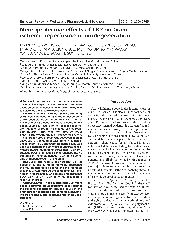摘要
AIM: The present study was conducted to investigate whether LBP had a protective effect on cerebral ischemic reperfusion injury and to determine the possible mechanisms. MATERIALS AND METHODS: Male Kunming (KM) mice were used to make the model cerebral artery occlusion/reperfusion (MCAO/R). The behavioral test was used to measure neurological deficit scores for evaluation of ischemic reperfusion damage of brain. The change of electroencephalograph (EEG) was monitored by Model SMUP-E Bio-electric Signals Processing System. The infarction area of brain was assessed in brain slices with 2% solution of 2,3,5-triphenyl tetrazolium chloride (TTC). Spectrophotometric assay was used to determine the activities of superoxide dismutase (SOD), glutathione peroxidase (GSH-Px), catalase (CAT) and lactate dehydrogenase (LDH), contents of malondialdehyde (MDA) and adenosine triphosphate (ATP) of the brain. RESULTS: The results showed that LBP at doses of 20 and 40 mg/kg markedly decreased the neurological deficit scores and the infarction area in MCAO/R mice. At the same time, LBP significantly decreased MDA content, and increased SOD, GSH-Px, CAT, LDH activities in ischemic reperfusion brain. CONCLUSIONS: These suggest that LBP might act as a potential neuroprotective agent against the cerebral reperfusion-induced injury in the brain through reducing lipid peroxides, scavenging free radicals, and improving the energy metabolism.
- 出版日期2013-10
- 单位宁夏医科大学
